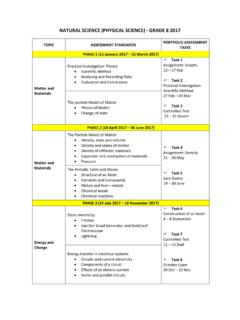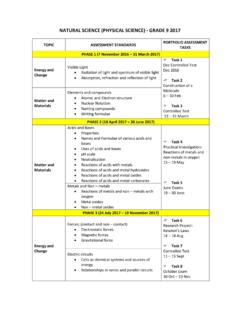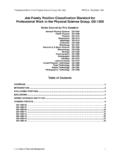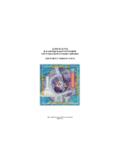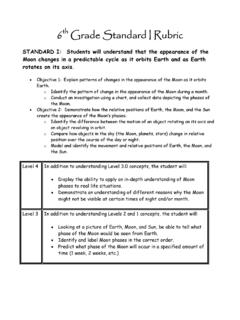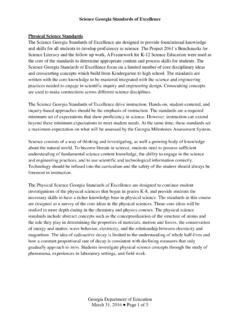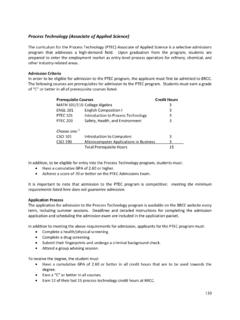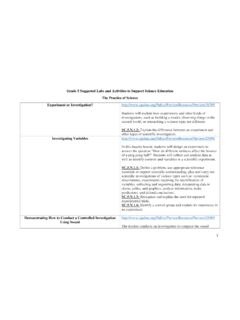Transcription of Earth’s Natural Resources - VDOE
1 Science Enhanced Scope and Sequence grade 1 virginia department of education 2012 1 earth s Natural Resources Strand earth Resources Topic Five senses and earth s Natural Resources Primary SOL The student will investigate and understand that Natural Resources are limited. Key concepts include a) identification of Natural Resources . Related SOL The student will demonstrate an understanding of scientific reasoning, logic, and the nature of science by planning and conducting investigations in which a) the senses are used to observe differences in physical properties; b) observations are made from multiple positions to achieve a variety of perspectives and are repeated to ensure accuracy; c) objects or events are classified and arranged according to characteristics or properties; f) inferences are made and conclusions are drawn about familiar objects and events; h) predictions are made based on patterns of observations.
2 I) observations and data are recorded, analyzed, and communicated orally and with simple graphs, pictures, written statements, and numbers; j) simple investigations and experiments are conducted to answer questions. Background Information Natural Resources are materials and components (something that can be used) that can be found within the environment. Air, water, sunlight, plants, animals, minerals, forests, and soil are examples of Natural Resources . Some Resources are renewable, which means they can grown back. Other Resources , however, are nonrenewable. They cannot be replaced or they take a very, very long time to be replaced or grow back.
3 Natural Resources are vital for us so it is important that we use them wisely. Materials Large display picture of a Natural scene the picture should include trees, flowers, animals, water, clouds, and sunlight at a minimum Six large zipped plastic bags Construction paper (colors should include red, orange, yellow, green, blue, and brown) construction paper should be cut into approximately 2x2 inch squares. You will need enough squares of each color so that about of your class can have five squares of each color. DO NOT cut enough squares for each student to have five of each color! Science Enhanced Scope and Sequence grade 1 virginia department of education 2012 2 A piece of each construction paper color from above that is folded in half lengthwise to make a label tent of each color.
4 Label the colored tents as follows: o Red Animals o Orange Minerals o Yellow Sunshine o Green Plants o Blue Water o Brown Soil and Land Sense Matrix Sheet for each student Student journals Outdoor classroom or outdoor setting, if available Vocabulary Natural Resources , plants, animals, water, air, land, minerals, forest, soil, renewable resource , non renewable resource Student/Teacher Actions (what students and teachers should be doing to facilitate learning) Introduction 1. Have the class sit in a large circle. Tell students that we are going to explore Natural Resources today. Ask What is a resource ? What is something that is Natural ?
5 What do you think we mean by Natural Resources ? (Take any answer right now.) Tell the students that we are going to discover what Natural Resources are. 2. Show the students the large picture of a Natural area. Have students name those things in the picture that they think are Natural Resources . (Guide them to find plants, animals, water, clouds, sunlight, etc.) Discuss why the Natural Resources are important to us. 3. Discuss what would happen if we pick the flowers. (We could plant more seeds and they will grow back.) 4. Discuss what would happen if we cut down all the trees. (We could plant new trees but it will take longer for them to reach the same size as those we cut down.)
6 5. Discuss what would happen if we pollute the water. (We will need to remove it which means we need to know how to clean it. If we don t know how to remove the particular contaminant, we will have to add time to find a way to remove it.) 6. Continue discussing the different Natural Resources and what would happen if we did not have one of them. Lead the students to realize that some Natural Resources are easily renewable and some are what we consider nonrenewable. Science Enhanced Scope and Sequence grade 1 virginia department of education 2012 3 Procedure 1 7. Tell students that we are going to play a game about Natural Resources .
7 8. Show the students the six zipped plastic bags with the small pieces of colored paper. Explain that each color represents a type of Natural resource . As you discuss each color, put out the tented label. Tell students that a. Red colored paper squares represent animals b. Orange represents minerals c. Yellow represents sunshine d. Green represents plants e. Blue represents water f. Brown represents soil or land 9. Tell the students that you are going to scatter the paper squares in the middle of the circle where they are sitting. Tell the students that in order to live, each student collector will need to be able to find five squares of each color.
8 The first time you do this, you will select five students to collect five squares of each of the colors. (There should be enough squares for all five students and there should be colored squares left on the floor.) 10. When the five students have gathered their colored squares, discuss with the class about whether there were enough squares for all five students to have the Natural Resources they need. Ask the students if there were enough Natural Resources ? Ask them if any of the Natural Resources are what we would consider nonrenewable? (yes) 11. Collect all of the squares and rescatter them on the floor. 12. This time have approximately 2/3 of your students collect squares.
9 (Again there should be enough, but there will be very few left on the floor.) 13. Discuss with the students what seems to be happening. (There are enough Resources for the collectors, but not much is left.) Ask the students what the number left means for the renewable Resources ? For the nonrenewable Resources ? 14. Collect all of the squares and re scatter them on the floor. 15. This time have the entire class collect squares. (There will not be enough squares for everyone to get five of each.) 16. Discuss with the class what it means for those students who were unable to collect enough squares of each color. Talk about the students who were unable to collect Science Enhanced Scope and Sequence grade 1 virginia department of education 2012 4 enough of the red or green squares.
10 (Many of these are considered renewable.) Talk about the students who were unable to collect enough orange or brown squares. (These would be considered non renewable.) 17. Collect all the squares. (Student helpers can later sort the colors for you.) 18. Talk with the students about ways we can be good stewards of our Natural Resources . (Things that a first grader can do could include: turn off the water while they brush their teeth, switch off lights when they leave a room, when something is broken, try to fix it instead of putting it in the trash, recycle, write on both sides of paper, use a washable cup instead of a paper cup, etc.)










